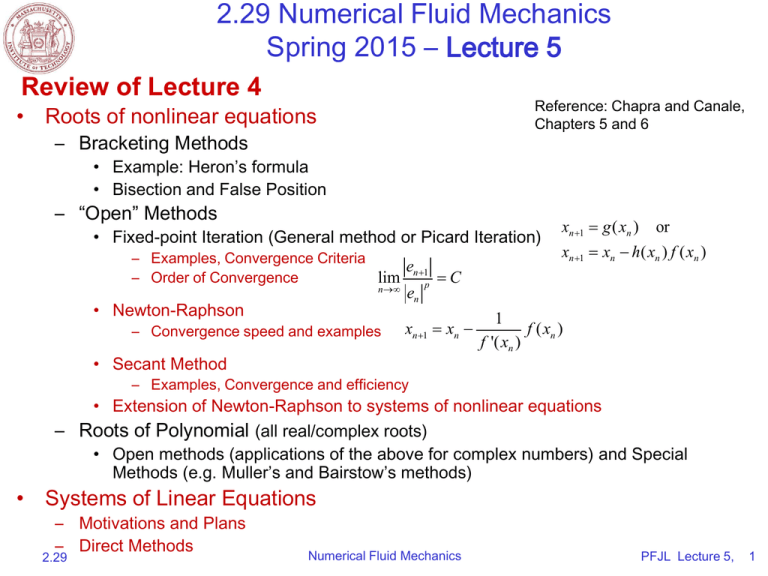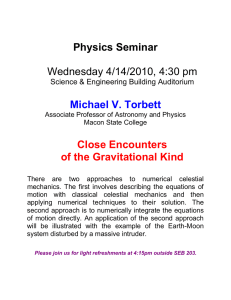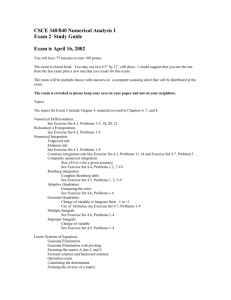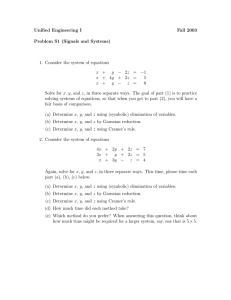2.29 Numerical Fluid Mechanics Spring 2015 – Lecture 5
advertisement

2.29 Numerical Fluid Mechanics Spring 2015 – Lecture 5 Review of Lecture 4 Reference: Chapra and Canale, Chapters 5 and 6 • Roots of nonlinear equations – Bracketing Methods • Example: Heron’s formula • Bisection and False Position – “Open” Methods • Fixed-point Iteration (General method or Picard Iteration) – Examples, Convergence Criteria e – Order of Convergence lim n 1p C n • Newton-Raphson – Convergence speed and examples xn 1 g ( xn ) or xn 1 xn h( xn ) f ( xn ) en xn 1 xn • Secant Method 1 f ( xn ) f '( xn ) – Examples, Convergence and efficiency • Extension of Newton-Raphson to systems of nonlinear equations – Roots of Polynomial (all real/complex roots) • Open methods (applications of the above for complex numbers) and Special Methods (e.g. Muller’s and Bairstow’s methods) • Systems of Linear Equations – Motivations and Plans – Direct Methods 2.29 Numerical Fluid Mechanics PFJL Lecture 5, 1 TODAY’s Lecture: Systems of Linear Equations • Direct Methods – Cramer’s Rule – Gauss Elimination • Algorithm • Numerical implementation and stability – – – – – Partial Pivoting Equilibration Full Pivoting Well suited for dense matrices Issues: round-off, cost, does not vectorize/parallelize well • Special cases, Multiple right hand sides, Operation count – LU decomposition/factorization – Error Analysis for Linear Systems – Condition Number – Special Matrices: Tri-diagonal systems • Iterative Methods 2.29 – Jacobi’s method – Gauss-Seidel iteration – Convergence Numerical Fluid Mechanics PFJL Lecture 5, 2 Reading Assignment • Chapters 9 and 10 of “Chapra and Canale, Numerical Methods for Engineers, 2006/2010/204.” – Any chapter on “Solving linear systems of equations” in references on CFD that we provided. For example: chapter 5 of “J. H. Ferziger and M. Peric, Computational Methods for Fluid Dynamics. Springer, NY, 3rd edition, 2002” 2.29 Numerical Fluid Mechanics PFJL Lecture 5, 3 Direct Methods for Small Systems: Determinants and Cramer’s Rule Linear System of Equations: Recall, for a 2 by 2 matrix, the determinant is: a11 a12 D a11 a22 a21 a12 a21 a22 Recall, for a 3 by 3 matrix, the determinant is: a11 a12 D a21 a22 a31 a32 2.29 a13 a22 a23 a11 a32 a33 a23 a21 a23 a21 a22 a12 a13 a33 a31 a33 a31 a32 Numerical Fluid Mechanics PFJL Lecture 5, 4 Direct Methods for small systems: Determinants and Cramer’s Rule i th column a11 Cramer’s rule: “Each unknown xi in a system of linear algebraic equations can be expressed as a fraction of two determinants: • Denominator is determinant D a • Numerator is D but with column i replaced by b” xi n1 Example: Cramer’s Rule, n=2 b1 a1n b2 bn D ann Numerical case: a a A 11 12 a21 a22 Cramer’s rule becomes impractical for n>3: The number of operations is of O(n!) 2.29 Numerical Fluid Mechanics PFJL Lecture 4, 5 Direct Methods for large dense systems Gauss Elimination • Main idea: “combine equations so as to eliminate unknowns systematically” – Solve for each unknown one by one – Back-substitute result in the original equations – Continue with the remaining unknowns Linear System of Equations • General Gauss Elimination Algorithm i. Forward Elimination/Reduction to Upper Triangular Systems) ii. Back-Substitution • Comments: • Well suited for dense matrices • Some modification of above simple algorithm needed to avoid division by zero and other pitfalls 2.29 Numerical Fluid Mechanics PFJL Lecture 4, 6 Gauss Elimination Reduction / Forward Elimination Step 0 Linear System of Equations If a11 is non zero, we can eliminate x1 from the remaining equations 2 to (n-1) by multiplying equation 1 with a i1 and subtracting the result from equation i . a 11 This leads to the following algorithm for “Step 1”: 2.29 Numerical Fluid Mechanics PFJL Lecture 4, 7 Gauss Elimination Reduction / Forward Elimination: Step 1 j Subtract multiple of row 1 from rows 2 to n a11 is called pivot element: (is called Pivot equation for step 1) i Notes: • Result of step 1: last (n-1) equations have (n-1) unknowns • Pivot a11 needs to be non-zero 2.29 Numerical Fluid Mechanics PFJL Lecture 4, 8 Gauss Elimination Reduction: Step k Recursive repetition of step 1 for successively reduced set of (n-k) equations: The result after completion of step k is: ( k 1) First non-zero element on row n: an ,k 1 xk 2.29 Numerical Fluid Mechanics PFJL Lecture 4, 9 Gauss Elimination Reduction/Elimination: Step k Back-Substitution Reduction: Step (n-1) Result after step (n-1) is an Upper triangular system! 2.29 Numerical Fluid Mechanics PFJL Lecture 4, 10 Gauss Elimination: Number of Operations Reduction/Elimination: Step k : n-k divisions : 2 (n-k) (n-k+1) additions/multiplications : 2 (n-k) additions/multiplications 3n( n 1) 2n( n 2 1) 2 For reduc., total number of ops: 3(n k ) 2( n k ) (n k 1) O( n3 ) 2 3 3 k 1 n 1 n ( n 1) Use: i and 2 i 1 n Back-Substitution n i i 1 2 n ( n 1) (2n 1) 6 : (n-k-1)+(n-k)+2=2(n-k) +1 additions/multiplications n 1 Hence, total number of ops is: 1 2(n k ) 1 1 (n 1)(n 1) n (the first 1 before the sum is for xn) k 1 2 3 n 2 ( i i 1 n (n 1) ) 2 Grand total number of ops is O ( n 3 ) O(n 3 ) : • Grows rapidly with n 2.29 • Most ops occur in elimination step Numerical Fluid Mechanics PFJL Lecture 5, 11 Gauss Elimination: Issues and Pitfalls to be addressed • Division by zero: (k ) – Pivot elements ak , k must be non-zero and should not be close to zero • Round-off errors – Due to recursive computations and so error propagation – Important when large number of equations are solved – Always substitute solution found back into original equations – Scaling of variables can be used • Ill-conditioned systems – Occurs when one or more equations are nearly identical – If determinant of normalized system matrix A is close to zero, system will be ill-conditioned (in general, if A is not well conditioned) – Determinant can be computed using Gauss Elimination • Since forward-elimination consists of simple scaling and addition of equations, the determinant is the product of diagonal elements of the Upper Triangular System 2.29 Numerical Fluid Mechanics PFJL Lecture 5, 12 Gauss Elimination: Pivoting Partial Pivoting by Columns Reduction Step k Row k Pivot Elements Row i Required at each step! 2.29 Numerical Fluid Mechanics PFJL Lecture 5, 13 Gauss Elimination: Pivoting Partial Pivoting by Columns: i.e. pivot is chosen with each column Reduction Step k New Row k Pivot Elements New Row i Required at each step! A. Partial Pivoting Two Solutions: i. Search for largest available coefficient in column below pivot element ii. Switch rows k and i B. Complete Pivoting i. As for Partial, but search both rows and columns ii. Rarely done since column re-ordering changes order of x’s, hence more complex code 2.29 Numerical Fluid Mechanics PFJL Lecture 5, 14 Gauss Elimination: Pivoting Example (for division by zero but also reduces round-off errors) Relatively close to zero Example, n=2 Direct Gaussian Elimination, no pivoting Cramer’s Rule - Exact 2-digit Arithmetic 100% error 1% error n=2 a = [ [0.01 1.0]' [-1.0 0.01]'] b= [1 1]' r=a^(-1) * b x=[0 0]; m21=a(2,1)/a(1,1); a(2,1)=0; a(2,2) = radd(a(2,2),-m21*a(1,2),n); b(2) = radd(b(2),-m21*b(1),n); x(2) = b(2)/a(2,2); x(1) = (radd(b(1), -a(1,2)*x(2),n))/a(1,1); x' tbt.m 2.29 Numerical Fluid Mechanics PFJL Lecture 5, 15 Gauss Elimination: Pivoting Example (for division by zero but also reduces round-off errors) Partial Pivoting Interchange Rows Example, n=2 2-digit Arithmetic Cramer’s Rule - Exact 1% error See tbt2.m 1% error Notes on coding: • Pivoting can be done in function/subroutine • Most codes don’t exchange rows, but rather keep track of pivot rows (store info in “pointer” vector) 2.29 Numerical Fluid Mechanics PFJL Lecture 5, 16 Gauss Elimination: Equation Scaling Example (normalizes determinant, also reduces round-off errors) Multiply Equation 1 by 200: this solves division by 0, but eqns. not scaled anymore! Example, n=2 2-digit Arithmetic Cramer’s Rule - Exact See tbt3.m 100% error 1% error Equations must be normalized for partial pivoting to ensure stability Row-based Infinity-norm Normalization Row-based 2-norm Normalization This Equilibration is made by normalizing the matrix to unit norm 2.29 Numerical Fluid Mechanics PFJL Lecture 5, 17 Examples of Matrix Norms “Maximum Column Sum” “Maximum Row Sum” “The Frobenius norm” (also called Euclidean norm)”, which for matrices differs from: “The l-2 norm” (also called spectral norm) 2.29 Numerical Fluid Mechanics PFJL Lecture 5, 18 Gauss Elimination: Full Pivoting Example (also reduces round-off errors) Pivoting searches both rows and columns Start from system where eq. 1 multiplied by 200: Example, n=2 Interchange Unknowns pivot chosen within each row, across all columns 2-digit Arithmetic Cramer’s Rule - Exact 1% error Full Pivoting Find largest numerical value in eligible rows and columns, and interchange Affects ordering of unknowns (hence rarely done) 2.29 Numerical Fluid Mechanics PFJL Lecture 5, 19 Gauss Elimination • Partial Pivoting Numerical Stability – Equilibrate system of equations (Normalize or scale variables) – Pivoting within columns – Simple book-keeping • Solution vector in original order • Full Pivoting – Does not necessarily require equilibration – Pivoting within both row and columns – More complex book-keeping • Solution vector re-ordered Partial Pivoting is simplest and most common Neither method guarantees stability due to large number of recursive computations (round-off error) 2.29 Numerical Fluid Mechanics PFJL Lecture 5, 20 Gauss Elimination: Effect of variable transform (variable scaling) Variable Transformation See tbt4.m Example, n=2 2-digit Arithmetic Cramer’s Rule - Exact 1% error 100% error 2.29 Numerical Fluid Mechanics PFJL Lecture 5, 21 Systems of Linear Equations Gauss Elimination How to Ensure Numerical Stability • System of equations must be well conditioned – Investigate condition number • Tricky, because it can require matrix inversion (as we will see) – Consistent with physics • e.g. don’t couple domains that are physically uncoupled – Consistent units • e.g. don’t mix meter and mm in unknowns – Dimensionless unknowns • Normalize all unknowns consistently • Equilibration and Partial Pivoting, or Full Pivoting 2.29 Numerical Fluid Mechanics PFJL Lecture 5, 22 Special Applications of Gauss Elimination • Complex Systems – Replace all numbers by complex ones, or, – Re-write system of n complex equations into 2n real equations • Nonlinear Systems of equations – Newton-Raphson: 1st order term kept, use 1st order derivatives – Secant Method: Replace 1st order derivatives with finite-difference – In both cases, at each iteration, this leads to a linear system, which can be solved by Gauss Elimination (if full system) • Gauss-Jordan: variation of Gauss Elimination – Elimination • Eliminates each unknown completely (both below and above the pivot row) at each step • Normalizes all rows by their pivot – Elimination leads to diagonal unitary matrix (identity): no back-substitution needed – Number of Ops: about 50% more expensive than Gauss Elimination (n3/2 vs. n3/3 multiplications/divisions) 2.29 Numerical Fluid Mechanics PFJL Lecture 5, 23 Gauss Elimination: Multiple Right-hand Sides AX=B Reduction Step k Total Computation Count = ? k Reduction: Nr . X= Back Substitution: Nb If n >> p, we expect Nr >> Nb But, if n ~ p ? n-k k (next slide) p n X is a [n x p] matrix 2.29 Numerical Fluid Mechanics PFJL Lecture 5, 24 Gauss Elimination: Multiple Right-hand Sides Number of Ops Reduction/Elimination: Step k : n-k divisions : 2 (n-k) (n-k+1) additions/multiplications : 2 (n-k) p additions/multiplication p equations as this one n 1 For reduction, the number of ops is: (2 p 1)(n k ) 2(n k ) * (n k 1) k 1 n( n 1) 2n( n 2 1) O ( n 3 pn 2 ) (2 p 1) 2 3 Back-Substitution : p * ( (n-k-1)+(n-k)+2 )= p * ( 2(n-k) +1 ) add./mul./div. n 1 2 Number of ops for back-substitution: p p 2(n k ) 1 p p (n 1)(n 1) p n (the first p before the sum is for the evaluations of the p xn’s) k 1 Grand total number of ops is O(n3 p n 2 ) : note, extra reduction/elimination only for RHS 2.29 Numerical Fluid Mechanics PFJL Lecture 5, 25 Gauss Elimination: Multiple Right-hand Sides Number of Ops, Cont’d Reduction at end of step k k k n-k p n i. Repeating reduction/elimination of A for each RHS would be inefficient if p >>> ii. However, if RHS is result of iterations and unknown a priori, it may seem one needs to redo the Reduction each time A x1 = b1, A x2 = b2, etc, where vector b2 is a function of x1, etc => LU Factorization / Decomposition of A 2.29 Numerical Fluid Mechanics PFJL Lecture 5, 26 MIT OpenCourseWare http://ocw.mit.edu 2.29 Numerical Fluid Mechanics Spring 2015 For information about citing these materials or our Terms of Use, visit: http://ocw.mit.edu/terms.


